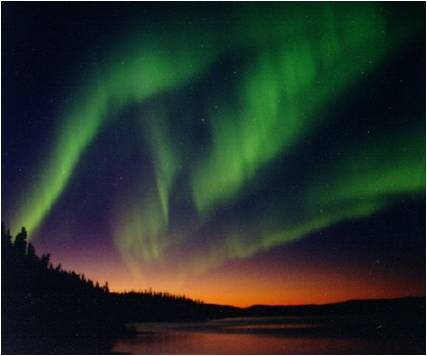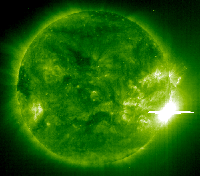Solar Wind Science - 3
Coronal Mass Ejection
The solar wind is not steady. There are times when the Sun unleashes huge amounts of mass and energy (ions, electrons, and magnetic fields) out into space. These large solar storms come from the Sun’s outermost atmosphere, known as the Corona. They are thus called Coronal Mass Ejections. When Coronal Mass Ejections travel past the STEREO spacecrafts, the speed of solar wind particles increases - as does the magnitude of the Interplanetary Magnetic Field (IMF). Often before these increases occur, high fluxes of very high energy particles (electrons and ions) pass by the STEREO spacecrafts first.
Click here (2MB, .avi) to watch one of STEREO satellites' observation of the Sun's corona. This is possible by placing a disk in front of the bright Sun to block the bright light from the Sun’s ‘surface.’ Blocking the Sun allows the STEREO camera to see the dim corona. As we watch, we are listening to sounds we have created from the solar wind speed, the high energy protons and electrons, and the magnetic field when it points toward the south. This solar wind data is taken at the same time as the camera on the satellite is observing the Sun."
So what?
 What does the solar wind do for you?
What does the solar wind do for you?
- Interacts with Earth’s magnetic field forming a magnetosphere
- If we could see the magnetosphere (but we can’t – magnetic fields are invisible), it would look kind of like a comet with a long tail pointing away from the Sun.
- The solar wind is not steady, just like Earth winds – sometimes weak, sometimes strong.
- Interaction with the magnetosphere can produce aurora or northern lights (nice)
- Interaction with the magnetosphere can also damage satellites usually protected by the magnetosphere (not so nice).
The sounds played earlier are created from information (data) about the solar wind: invisible solar particles and magnetic fields.
- These invisible particles and magnetic fields do not make sounds - we have had to change the information to sounds in order to listen to them, analogous to making sounds from temperature data coming from buoys in the ocean.
- The solar data is sent to Earth from each spacecraft. Our MAX-MSP program downloads the data and changes it to sound
- Data from the ‘Ahead’-of-Earth spacecraft plays in the right speaker. Data from the ‘Behind’-of Earth spacecraft plays in the left speaker.
- See our Sounds Page to download the program to listen to more sounds, or listen to more example sounds.
Solar Flare
- Associated with solar wind, but not solar wind
- Outputs energy in electromagnetic waves, not plasma nor ionized particles as do solar wind and CME's
- Characterized by a sudden, on the scale of minutes, burst of energy outward
- Can be described as a "flare of light"
- Usually seen in x-ray wavelength as a flare of brightness
- Does output in visible wavelength, but very little
Solar Flare are associate with solar wind and CME's though the relevance is not entirely clear. Solar flare is not solar wind. While solar wind constantly output charged particles, solar flares rapidly erupt at intervals like CME's, however solar flares do not output particles, ions or plasmas. Instead, solar flares output energy, in the form of electromagnetic waves. Solar flares output this electromagnetic energy in different wavelengths and we have classified solar flares according to the peak output wavelength. Usually solar flares peak in the x-ray wavelength.




